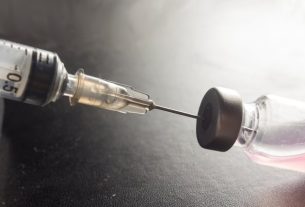Subclinical hyperthyroidism is the change in TSH levels in the blood, which are low or undetectable, with normal levels of T3 and T4, which are hormones produced by the thyroid.
This condition normally has no symptoms, however, it can lead to changes in the cardiovascular and bone system, increasing the risk of complications such as arrhythmias, osteoporosis or osteopenia, especially in the elderly.
Subclinical hyperthyroidism is detected by an endocrinologist through tests that evaluate the thyroid, and treatment varies according to its cause, severity of the disease, TSH levels, in addition to the presence of risk factors and complications.

Symptoms of Subclinical Hyperthyroidism
Subclinical hyperthyroidism normally has no symptoms, and in some cases the person may present symptoms of hyperthyroidism, such as palpitations, tremors, heat intolerance or irritability, for example. See how to identify the symptoms of hyperthyroidism.
Furthermore, subclinical hyperthyroidism can cause changes in the cardiovascular system, such as arrhythmias, heart failure, atrial fibrillation or coronary disease, especially in the elderly.
Subclinical hyperthyroidism can also cause dementia or lead to a decrease in bone density, and result in osteoporosis or osteopenia, particularly in postmenopausal women.
How to confirm the diagnosis
The diagnosis of subclinical hyperthyroidism is made by an endocrinologist by carrying out tests that evaluate thyroid hormones, such as T3, T4 and TSH, and antithyroid antibodies. Check out the main tests that evaluate the thyroid.
Make an appointment with an endocrinologist in the nearest region:
Taking care of your health has never been easier!
Through the blood test, it is possible to confirm the diagnosis, since the results show TSH levels below reference values or even being undetectable in the exam, and T3 and T4 with normal values. See the TSH test reference values.
Furthermore, based on TSH values, the doctor can classify subclinical hyperthyroidism as mild or severe.
Other tests that the doctor may order to confirm subclinical hyperthyroidism are ultrasound and thyroid scintigraphy, to identify its cause and assess the need for treatment.
Classification of subclinical hyperthyroidism
Hyperthyroidism is classified based on TSH levels in the blood, and includes:
- Mild subclinical hyperthyroidism: blood TSH levels are between 0.1 and 0.4 μIU/mL;
- Severe subclinical hyperthyroidism: blood TSH levels are below 0.1 μIU/mL.
In all cases, the levels of T3 and T4, which are hormones produced by the thyroid, are within normal values. Check the normal values of T3 and T4 in the blood.
Possible causes
Subclinical hyperthyroidism can be caused by increased production of thyroid hormones by the body or by excessive use or high doses of levothyroxine.
Thus, the main factors that can lead to subclinical hyperthyroidism are:
- Graves’ disease;
- Toxic nodular goiter;
- Toxic adenoma;
- Thyroid cancer treatment;
- Central hypothyroidism;
- Excessive treatment with levothyroxine;
- Medicines to lower TSH levels, such as corticosteroids or dopamine.
In addition, silent, postpartum, or drug-induced subacute thyroiditis can also cause subclinical hyperthyroidism. Check out the main types of thyroiditis and how it is treated.
Types of subclinical hyperthyroidism
Subclinical hyperthyroidism can be classified according to the cause into:
- Endogenous subclinical hyperthyroidism: it is related to the increased production and secretion of hormones by the thyroid, which is what happens with excessive use or high doses of levothyroxine;
- Exogenous subclinical hyperthyroidism: The changes are not directly linked to the thyroid gland, and may occur in cases of goiter, thyroiditis, toxic adenoma or Graves’ disease, for example.
The type of hyperthyroidism is identified by the doctor through diagnostic tests, allowing the doctor to indicate the most appropriate treatment, if necessary.
How the treatment is carried out
The treatment of subclinical hyperthyroidism must be carried out with the guidance of an endocrinologist based on the assessment of the person’s general health status, presence of symptoms or risk factors.
In some cases it is not necessary to start treatment, as these may only be temporary changes, that is, due to some situations experienced by the person that led to changes in TSH levels, but which then return to normal.
However, in other situations, it is possible that hormonal levels do not return to normal, on the contrary, TSH levels may become increasingly lower and T3 and T4 levels higher, characterizing hyperthyroidism.
In these cases, it is necessary to initiate appropriate treatment, which may be through the use of medicines that regulate hormone production, treatment with radioactive iodine or surgery. Understand how hyperthyroidism is treated.
When to treat subclinical hyperthyroidism?
Treatment of subclinical hyperthyroidism is recommended when TSH levels are less than 0.1 μIU/mL, in the following situations:
- People aged 60 or more;
- People under 60 with heart diseaseosteoporosis or symptoms of hyperthyroidism;
- Postmenopausal womenunder 65 years of age and who do not take hormone replacement therapy or use bisphosphonates.
For these same people with TSH levels between 0.1 and 0.4 μIU/mL, the doctor may also consider treatment for subclinical hyperthyroidism if necessary.
In the case of people under 60 years of age without symptoms and with TSH levels between 0.1 and 0.4 μIU/mL, only observation and follow-up tests may be recommended. In these cases, the person must undergo further tests within 2 to 6 months to confirm the need to take medication.

Sign up for our newsletter and stay up to date with exclusive news
that can transform your routine!
Warning: Undefined array key "title" in /home/storelat/public_html/wp-content/plugins/link-whisper-premium/templates/frontend/related-posts.php on line 12
Warning: Undefined array key "title_tag" in /home/storelat/public_html/wp-content/plugins/link-whisper-premium/templates/frontend/related-posts.php on line 13



